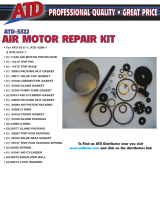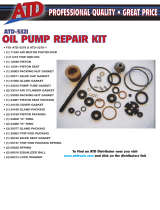Page is loading ...

ATD-5218 MADE IN MEXICO GREASE CONTROL VALVE
FOR AIR OPERATED CHASSIS PUMP
MAXIMUM RATED PRESSURE – 7500 PSI
INLET: 1/4”; Includes Extension Tube and High Pressure
Zerk Coupler
OWNERS MANUAL
RETAIN THIS MANUAL FOR FUTURE REFERENCE TO IMPORTANT WARNINGS AND
OPERATING AND MAINTENANCE INSTRUCTIONS.
PROPER USE AND MAINTENANCE OF THIS EQUIPMENT IS THE RESPONSIBILITY OF THE
OWNER AND/OR OPERATOR.
DO NOT USE THIS EQUIPMENT UNLESS YOU HAVE CAREFULLY READ AND
UNDERSTAND THE INSTRUCTIONS AND WARNINGS IN THIS MANUAL.
! WARNING !
NEVER exceed the stated maximum working pressure of the pump or of the lowest rated component in your
system.
NEVER modify any part of this equipment.
NEVER use combustible gas with this equipment.
NEVER attempt repairs while the system is under pressure.
NEVER attempt to disassemble the equipment while the system is under pressure.
ALWAYS tighten fluid connections before using this equipment
ALWAYS read/follow the fluid manufacturer’s recommendations regarding fluid compatibility.
ALWAYS read/follow the fluid manufacturer’s recommendations regarding the use of protective clothing
and equipment.
ALWAYS use an air line filter/moisture eliminator at the air inlet for the pump.
ALWAYS use air line lubricator.
REGULARLY check all equipment and repair/replace worn or damaged parts immediately.
FAILURE TO HEED THESE WARNINGS INCLUDING OVERPRESSURIZING,
ALTERING PARTS, USE OF INCOMPATIBLE FLUIDS, MISUSE, OR USE OF
DAMAGED/WORN PARTS MAY RESULT IN EQUIPMENT DAMAGE,
PROPERTY DAMAGE, FIRE, EXPLOSION AND/OR SERIOUS PERSONAL
INJURY.
SAFETY INSTRUCTIONS
Extreme caution should be used when operating this equipment as it generates very high fluid pressure.
Leaks from loose or ruptured components or material from dispensing valve can inject fluid through the skin
causing serious bodily injury and possible need for amputation. Always wear protection to prevent material
splashing onto skin or into eyes.
IMPORTANT:
GET EMERGENCY MEDICAL CARE IMMEDIATELY IF ANY FLUID APPEARS TO
PENETRATE THE SKIN! INFORM PHYSICIAN OF EXACTLY WHAT WAS INJECTED. PLEASE
DO NOT TREAT THIS INJURY AS A SIMPLE CUT.

! WARNING ! – RELIEF PROCEDURE
DO NOT EVER point the dispensing valve at another person.
DO NOT EVER attempt to stop material from the dispensing valve or a leaking connection with your hand
or body.
BEFORE EACH USE, check equipment for proper operation and to insure safety devices are in place and
working properly.
NEVER modify this equipment. Modification could cause equipment malfunction and resulting serious
bodily injury.
When flushing the pump with solvents, ALWAYS hold a metal part of the dispensing valve firmly to the
side of a grounded metal pail and operate pump at the lowest possible fluid pressure to reduce the risk of
injury from splashing or static sparking.
WARNING: This pump can develop 7500 PSI working pressure at 125 PSI maximum incoming air
pressure. Be sure that all system equipment and accessories are rated to withstand the maximum working
pressure of this pump. NEVER exceed the maximum working pressure of the lowest rated component in the
system. IMPORTANT: “Whip” hoses for dispensing valve are fluid pressure rated at 4500 PSI. NEVER
exceed 90 PSI, air pressure to pump when using “whip” hoses.
WARNING: Water and even moist air can cause this pump to corrode. To aid in the prevention of this
corrosion, NEVER leave the pump filled with water or air. After normal flushing, flush the pump once more
with mineral spirits or an oil based solvent, relieve pressure and leave the mineral spirits in the pump. It is
strongly suggested to put 2-4 fl oz of Lubricating Oil in the Air Motor Inlet every week for Proper
Lubrication. Never use a Synthetic Oil as this will cause irreparable damage to the pump. BE SURE
TO CORRECTLY FOLLOW THE PRESSURE RELIEF PROCEDURE.
PRESSURE RELIEF PROCEDURE
ALWAYS FOLLOW THIS PROCEDURE to reduce the risk of serious bodily injury, including splashing
into the eyes. After shutting off the pump; checking/servicing any part of the system; installing/cleaning or
changing any part of the system, ALWAYS follow this procedure:
1. Disconnect the air supply to the pump.
2. Aim the dispensing valve away from yourself and others.
3. Aim the dispensing valve into an appropriate container and open until all pressure is relieved.
If you believe that the dispensing valve or hose is completely clogged or that pressure in the pump has not
been fully relieved after following the above procedure, VERY SLOWLY loosen the hose end coupling to
relieve the pressure gradually and then loosen completely. Then proceed to clear the valve or hose.
WARNING: ALWAYS follow the Pressure Relief Procedure after shutting off the pump.
WARNING: ALWAYS follow the Pressure Relief Procedure when checking/servicing any part of the
system and when installing, cleaning or changing any part of the system.
INSPECTION INSTRUCTIONS
If you believe that you have overpressurized the equipment, or if your equipment requires adjustments or
repair, contact ATD’s service center at 1-800-328-2897 for inspection of the pump.
LUBRICATION: It is recommended to lubricate the Air Motor once a week with 2-4fl oz of Common Lubricating
Motor Oil injected into the Airlet port of the Air Motor. This will ensure maximum life of the Air Motor. Never use a Synthetic
Oil to Lubricate the Air Motor and this will swell the Buna-N rubber packings and cause irreparable damage.
INSTALLATION
It is recommended that you use an air line filter/regulator/lubricator to remove harmful dirt
and moisture from the compressed air supply and to provide automatic lubrication to the air motor. Blow-
dry the lines and hoses with air before connecting them to the system.
ATD WARRANTY & SERVICE CENTER MAY BE CONTACTED AT 1-800-328-2897.

WARNING: AVOID INJURY: DO NOT
COME IN CONTACT WITH ANY BODY
PARTS WITH THE NOZZLE TO
PREVENT INJURY
AVAILABLE MODELS
MODEL
W/ ACC
COUPLNG NUT INLET
ATD5218
W/ 62028ME ATD5258
12869ME 1/4" NPT(F)
LT82393ME
W/O 62028ME ATD5258
12869ME 1/4" NPT(F)
LT3050ME
W/ 62028ME ATD5258
11396ME 3/8" NPT(F)
LT81495ME
W/O 62028ME ATD5258
11396ME 3/8" NPT(F)

TROUBLESHOOTING GUIDE FOR HIGH PRESSURE CONTROL VALVES
Greases leaks out of the coupler ATD5258 when handle is not
depressed.
Clean ball 66255ME and Seat 11364ME; If seat is pitted on one
side, reverse it.
No Grease is pumped out of the coupler ATD5258 when handle
is depressed
Clean ball 66255ME and Seat 11364ME; If seat is pitted on one
side, reverse it.
Grease Leaks out of the top Replace packing 35007ME
MAINTENANCE :
If lubricant continues to flow from the ATD5258 Coupler after the handle is released, the ball is not sealing against
the check seat. Remove and examine the check seat and the ball by unthreading the coupling nut. If the ball is not
perfectly smooth, replace it. The check seat has a ball seat on both sides. If the ball seat being used is rough, worn
or pitted, invert the check seat and reassemble the control valve. If both sides of the check seat are damaged
replace the check seat and ball or use the 82157ME Repair Kit. After assembly, the adjustment nuts at the top of
the control valve should be adjusted as in Figure ''A". To prevent damage to the check seat, do not adjust for less
than 1/32" pull rod travel.
OPERATION OF THE CONTROL VALVE:
All 4 High Pressure control valves were designed to control the flow of lubricant from high pressure air operated
pumps. Only a small pull of the trigger on the control valve handle is required to obtain sensitive flow control.
When the 45788ME Handle is in its normal position the 55029ME Spring acts thru the 11363ME Ball Retainer to seat
the 66255ME Ball against the 11364ME Check Seat, preventing lubricant flow thru the control valve. When the
handle is depressed, the 11362ME Rod and ball retainer move up, compressing the spring, allowing lubricant
pressure to unseat the ball and flow thru the control valve. The ball retainer limits the travel of the ball. Thus, the
lubricant flow rate is determined b
y
the distance the handle is de
p
ressed.
FIGURE “A” ADJUSTING
CONTROL VALVE:
1/32” MIN MOVE
1/16” MAX MOVE
ROD MAY PROTRUDE
5/32” MAX
REPAIR PARTS
QTY PART # DESCRIPTION
1 5834
HYDRAULIC COUPLER W/
EXTENSION
1 ATD5258 HYDRAULIC COUPLER
1 10181 NOZZLE ADAPTER
1 11356 CONTROL VALVE BODY
1 11362
PULL ROD
*
1 11363 BALL RETAINER
1 11364
CHECK SEAT
*
1
11396 3/8" NPTF COUPLING NUT
1 11837 TOGGLE PIVOT SCREW
1 12826 PACKING GLAND
1 12828 PIVOT BAR
1
12869 1/4" NPTF COUPLING NUT
1 35007
VALVE STEM PACKING
*
1 45788 HANDLE
1 45820 TOGGLE LINK
1 48218
PACKING WASHER
*
3 51043 LOCKNUT
1 55029 FRICTION SPRING
1 62028 NOZZLE EXTENSION
1 66177 TOGGLE PIN
1 66255
STEEL BALL
*
1 66011 STEEL BALL
* Included in Repair Kit 82157ME
/





